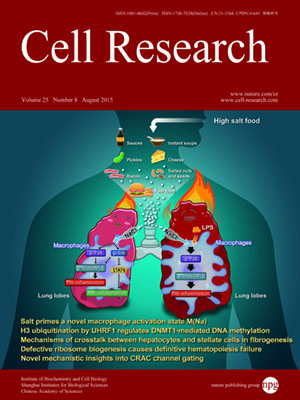
Volume 25, No 8, Aug 2015
ISSN: 1001-0602
EISSN: 1748-7838 2018
impact factor 17.848*
(Clarivate Analytics, 2019)
Volume 25 Issue 8, August 2015: 893-910 | Open Access
ORIGINAL ARTICLES
High salt primes a specific activation state of macrophages, M(Na)
Wu-Chang Zhang1,*, Xiao-Jun Zheng1,*, Lin-Juan Du1,*, Jian-Yong Sun1, Zhu-Xia Shen1, Chaoji Shi2, Shuyang Sun2, Zhiyuan Zhang2, Xiao-qing Chen3, Mu Qin3, Xu Liu3, Jun Tao4, Lijun Jia5, Heng-yu Fan6, Bin Zhou1, Ying Yu1, Hao Ying1, Lijian Hui7, Xiaolong Liu7, Xianghua Yi8, Xiaojing Liu9, Lanjing Zhang10,11,12,13 and Sheng-Zhong Duan1
1Key Laboratory of Nutrition and Metabolism, Institute for Nutritional Sciences, Shanghai Institutes for Biological Sciences, Chinese Academy of Sciences, University of the Chinese Academy of Sciences, Shanghai 200031, China
2Shanghai Key Laboratory of Stomatology, Department of Oral and Maxillofacial-Head Neck Oncology, Ninth People's Hospital, Shanghai Jiao Tong University School of Medicine, Shanghai 200011, China
3Department of Cardiology, Shanghai Chest Hospital, Shanghai Jiao Tong University, Shanghai 200030, China
4Department of Hypertension and Vascular Disease, The First Affiliated Hospital, Sun Yat-Sen University, Guangzhou, Guangdong 510080, China
5Cancer Institute, Fudan University Shanghai Cancer Center, Fudan University, Shanghai 200032, China
6Life Sciences Institute and Innovation Center for Cell Biology, Zhejiang University, Hangzhou, Zhejiang 310058, China
7State Key Laboratory of Cell Biology, Institute of Biochemistry and Cell Biology, Shanghai Institutes for Biological Sciences, Chinese Academy of Sciences, Shanghai 200031, China
8Department of Pathology, Tongji Hospital, Tongji University School of Medicine, Shanghai 200065, China
9Laboratory of Cardiovascular Diseases, Regenerative Medicine Research Center, West China Hospital, Sichuan University, Chengdu, Sichuan 610041, China
10Department of Pathology, University Medical Center of Princeton, Plainsboro, NJ, USA
11Department of Chemical Biology, Ernest Mario School of Pharmacy, Rutgers University, Piscataway, NJ, USA
12Department of Pathology, Robert Wood Johnson Medical School, Rutgers University, Piscataway, NJ, USA
13Cancer Institute of New Jersey, Rutgers University, Piscataway, NJ 08854-8020, USA
Correspondence: Sheng-Zhong Duan, Tel/Fax: +86-21-5492-0981(szduan@sibs.ac.cn)
High salt is positively associated with the risk of many diseases. However, little is known about the mechanisms. Here we showed that high salt increased proinflammatory molecules, while decreased anti-inflammatory and proendocytic molecules in both human and mouse macrophages. High salt also potentiated lipopolysaccharide-induced macrophage activation and suppressed interleukin 4-induced macrophage activation. High salt induced the proinflammatory aspects by activating p38/cFos and/or Erk1/2/cFos pathways, while inhibited the anti-inflammatory and proendocytic aspects by Erk1/2/signal transducer and activator of transcription 6 pathway. Consistent with the in vitro results, high-salt diet increased proinflammatory gene expression of mouse alveolar macrophages. In mouse models of acute lung injury, high-salt diet aggravated lipopolysaccharide-induced pulmonary macrophage activation and inflammation in lungs. These results identify a novel macrophage activation state, M(Na), and high salt as a potential environmental risk factor for lung inflammation through the induction of M(Na).
10.1038/cr.2015.87
FULL TEXT | PDF
Browse 2192


